Songkran
Songkran (สงกรานต์)is the most important feast for Thai people. Songkran event normally falls on the15th full moon but the government of Phibulsongkran fixed Songkran asthe 13th of April prior to World War II.Often called "water festival", Songkran is the ancient New Year's Day happeningmid April. Now the official New Year's Day happens the 1st January.Those ladies carry on the tradition of accepting sand into the templein order to build sand stupas.
For Songkran festival, Thai people clean everything, i.ethe house, the previous year bad actions, the Buddha statues, one's own spirit. But nowadaysSongkran festival is better known for its splashing water madness.Traditionally the ceremony was to pour water into the palms hands inorder that bad actions, bad thoughts flow away with the water. It was away to purify. Children show their respectto elders by performing this water ceremony. Also scented water ispoured over the shoulder and slowly down the back of the person. Whilepouring the water in this manner, people say good wishes and words ofblessing for the coming New Year.
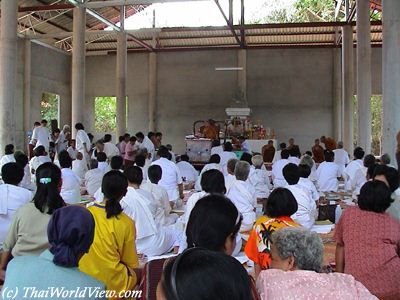 The first day of Songkran period is an important day to makegood deeds. People visit temples to listen to Dharma. Also theygive alms to monks.
The first day of Songkran period is an important day to makegood deeds. People visit temples to listen to Dharma. Also theygive alms to monks. 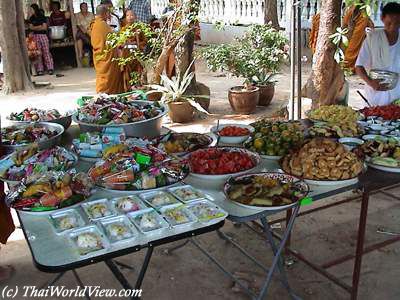 Sonkran is a time for celebration. Young people workingin Bangkok and big cities come back to the village. They return because this is an opportunityof social reunification. They meet with their family, friends and relatives within the community.
Sonkran is a time for celebration. Young people workingin Bangkok and big cities come back to the village. They return because this is an opportunityof social reunification. They meet with their family, friends and relatives within the community. 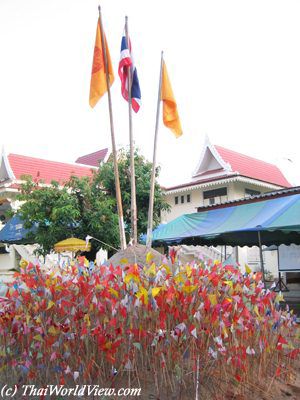 Food is offered to monks. The food left is shared bythe nuns and the people offering alms.
Food is offered to monks. The food left is shared bythe nuns and the people offering alms. On the second day of the New Year festival, Thai people traditionalycarry sand into temples compounds in order to build a smallpagoda ("PHRA CHEDI SAI" - พระเจดีย์ทราย).These sand piles represent personal pagodas built as part of the merit-making ritual.People leaving a temple during the previous year have taken withthem temple dust. Taking sand into the temple during Songkran festivalatones for what they have taken out.
People also donate flags(ธงปักทราย - "THONG PAK SAY")to sand pagoda. It is believed to bring luck andconsidered as a revered offering to the temple.
Thai Buddhist temples traditionally move what are believed to betheir holiest statues to open-air pavilions during the Thai New Yearto allow worshippers to sprinkle them with water.It sometimes happens that ancient Buddha statues were stolen fromshrines erected outside temples to accommodate Thai worshippers.Buddhist artefacts are frequently smuggled from rural Thailand and neighbouringCambodia to Bangkok markets, where they are often sold to foreign collectors.
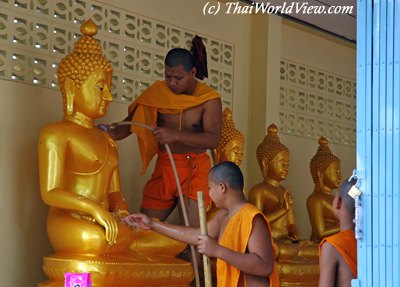 In the past, young people poured scented water over the handsof their parents and elders to show respect. Nowadays the celebrations typically degenerate.Youths wander the streets of cities in pickup trucks throwing buckets of ice water atpedestrians and motorcyclists. Others stand on street corners shooting passers-bywith high-pressure water guns.
In the past, young people poured scented water over the handsof their parents and elders to show respect. Nowadays the celebrations typically degenerate.Youths wander the streets of cities in pickup trucks throwing buckets of ice water atpedestrians and motorcyclists. Others stand on street corners shooting passers-bywith high-pressure water guns.At the temple the rite of pouring water on Buddha statues, which has been cleaned bythe monks, is performed. The ceremony is known as "ROD NAM DAM HUA"(รดน้ำดำหัว).
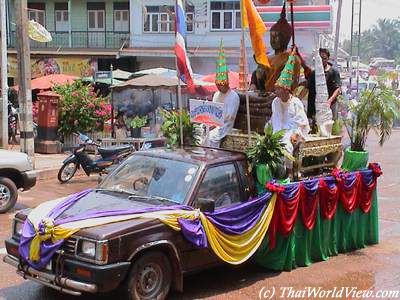 Songkran festival lasts officially three days.But it often starts one day before if the weather is very hot. Alladministrations and banks are closed. Most people living in Bangkokgo back up-country to visit their relatives and to participate to Songkranfeast. During Songkran festival there is no traffic jams in Bangkok.Many houses nationwide are put under police watch during Songkran.
Songkran festival lasts officially three days.But it often starts one day before if the weather is very hot. Alladministrations and banks are closed. Most people living in Bangkokgo back up-country to visit their relatives and to participate to Songkranfeast. During Songkran festival there is no traffic jams in Bangkok.Many houses nationwide are put under police watch during Songkran.During Thai New Year parade Buddha statues are settled on cars.People sprinkle holy water on the statue to purify it.
During Songkran festival, Thai people symbolically bathethe monks ("SONG NAM PHRA" - ทรงน้ำพระ). It is an old ritual topay respect to monks.
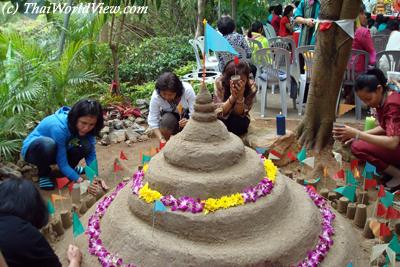
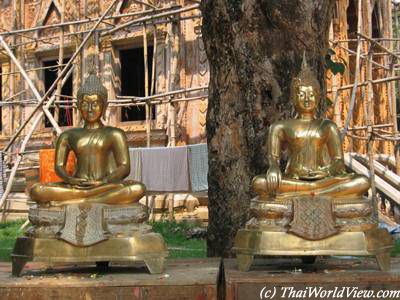
Tidak ada komentar:
Posting Komentar